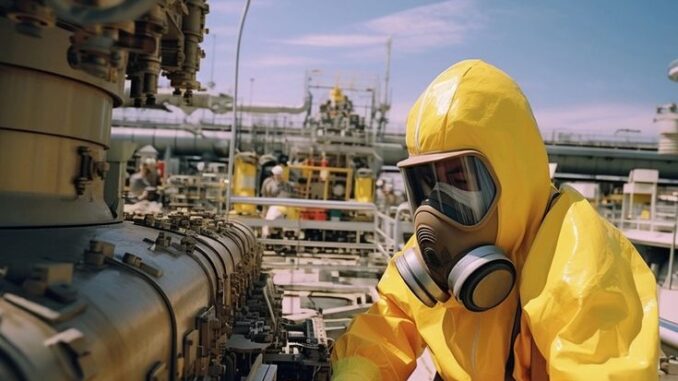
Hydrochloric Acid
Key Characteristics
Substance Type: Hydrochloric Acid Toxic and/or corrosive liquid
Non-Combustible: Hydrochloric Acid does not catch fire but poses other significant hazards
Potential Hazards: Hydrochloric Acid
Health Risks
Inhalation or direct contact may result in severe or even fatal injury.
Skin and eye exposure may lead to deep burns.
Breathing its fumes or mist can cause irritation to the respiratory system, fluid buildup in the lungs (pulmonary edema), or fatal outcomes.
Delayed effects: Symptoms or complications might not appear immediately.
Fire and Explosion Risks
Does not ignite easily, but exposure to extreme heat can break it down, releasing hazardous gases such as chlorine and hydrogen chloride.
Container hazards: Heated containers could explode.
Reactivity: May react intensely with water or certain metals, leading to the release of highly flammable hydrogen gas.
Public Safety Guidelines: Hydrochloric Acid
Emergency Contact
Dial emergency number
Isolation Measures
For large spills: Set up an isolation zone of at least 100 meters (330 feet) in every direction.
If fire is present: Increase the isolation distance to 800 meters (1/2 mile) all around.
Protective Equipment
Wear a chemical-resistant suit and use a self-contained breathing apparatus (SCBA).
Remain upwind and away from low-lying areas.
Ensure adequate ventilation in enclosed spaces.
Emergency Response Actions: Hydrochloric Acid
Fire Response
Small fires: Use dry chemical extinguishers, carbon dioxide (CO₂), or a careful spray of water.
Large fires: Use water spray or fog (not solid streams); cool any containers from a safe distance.
Spill or Leak Protocols
Remove all possible sources of ignition.
Avoid touching the spilled material.
Stop the leak if possible safely.
Use water spray to suppress vapors, but do not let the material spread.
Never let the acid reach sewers or natural water sources.
Do not use water jets or attempt to neutralize the spill unless professionally trained.
First Aid Measures
Quickly move the exposed person to fresh air.
Contact emergency medical services immediately.
If inhaled: Administer oxygen if necessary.
For skin or eye exposure: Remove any contaminated clothing and rinse the affected area with running water for a minimum of 20 minutes.
If swallowed: Do not induce vomiting. Rinse the mouth and provide water when awake and alert.
Keep calm and warm.
Remember: Some symptoms or injuries may arise later—seek professional medical attention as quickly as possible.
Prevention and Safe Handling
Ventilation and Safety Equipment:
Always use hydrochloric acid in areas with proper ventilation, such as spaces equipped with fume hoods. It’s essential to have emergency eyewash stations and safety showers nearby in case of accidental exposure.
Storage Precautions:
Keep hydrochloric acid stored in tightly sealed containers. The storage area should be cool, dry, well-ventilated, and isolated from incompatible materials like bases and metals, as these can cause dangerous reactions.
Safe Handling Practices of Hydrochloric Acid
Avoid inhaling the acid’s fumes and never eat, drink, or smoke when handling this chemical. After any handling, wash your hands and any exposed skin thoroughly. Make sure everyone using hydrochloric acid has read its Safety Data Sheet (SDS) and is trained to respond safely to spills or accidents.
Environmental Protection
Preventing Releases of Hydrochloric Acid
Take care to prevent hydrochloric acid from reaching drains or bodies of water, as it is hazardous to aquatic life and can damage the environment.
Spill Management of Hydrochloric Acid
If a spill occurs, use appropriate neutralizers and absorbent materials to contain it. Clean up all residues and waste promptly, placing them in clearly labeled hazardous waste containers for proper disposal. Follow all local regulations when discarding these materials.
Emergency Response: Hydrochloric Acid
Area Isolation
For small leaks, section off the impacted area and prevent entry.
For major spills, evacuate the vicinity following your workplace’s emergency protocols.
Maintain isolation of 100 meters for significant spills, and 800 meters if there is a large fire.
Personal Protective Equipment
Always use appropriate PPE—this includes acid-resistant gloves, boots, protective suits, goggles, and a suitable respirator. For minor incidents, at minimum wear splash goggles and gloves. For larger emergencies, use a full protective suit and a self-contained breathing apparatus.
Containment and Neutralization:
For controlling spills, use barriers like sand, clay, or chemical pads to limit the spread. Some absorbents and organic materials may react with hydrochloric acid—only use materials recommended for acid spills. To neutralize spills, apply neutralizing agents such as baking soda, soda ash, lime.
Disposal: Hydrochloric Acid
Gather all absorbents, neutralized material, and contaminated items into appropriately marked hazardous waste containers.
Follow local procedures.
Be the first to comment